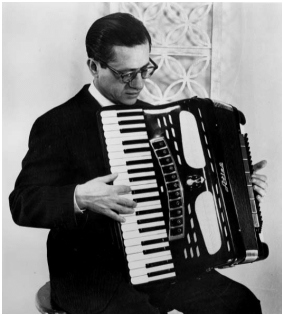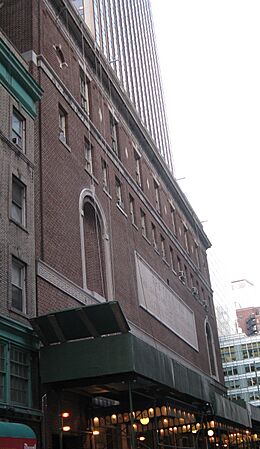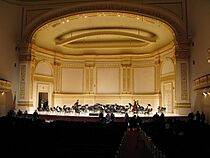John Serry Sr. facts for kids
Quick facts for kids
John Serry
|
|
|---|---|

John Serry in 1967
|
|
| Born | January 29, 1915 Brooklyn, United States
|
| Died | September 14, 2003 (aged 88) Long Island, United States
|
| Occupation | Accordionist, Organist, Educator, Composer |
| Years active | 1930-2002 |
John Serry Sr. (born John Serrapica; January 29, 1915 – September 14, 2003) was a talented American musician. He was a concert accordionist, arranger, composer, organist, and teacher. John Serry Sr. performed on major networks like CBS Radio and Television. He also helped with Voice of America's efforts to share American culture with other countries. For nearly 40 years, from the 1930s to the 1960s, he played the accordion in orchestras and jazz bands.
Contents
- John Serry Sr.: A Musical Journey
- Early Life and Musical Training
- Performing on Big Stages
- The Big Band Era
- The Golden Age of Radio
- A Dedicated Music Teacher
- Broadway and Television Appearances
- Later Career and Legacy
- His Performance Style
- His Music and Compositions
- What He Recorded
- Film Appearances
- His Invention
- Where His Work Is Kept
- Professional Groups He Joined
- See also
John Serry Sr.: A Musical Journey
John Serry Sr.'s music career lasted for over 70 years. He loved Latin American music and played a special kind of accordion called the free-bass accordion. He was the main accordionist on a radio show called Viva América. This show was broadcast live to South America during World War II. It was part of a program by the U.S. government to share culture. The show helped introduce Latin American music and the Mexican bolero to many people in the United States in the 1940s.
Early Life and Musical Training
John Serry was born John Serrapica in Brooklyn, New York. He was one of 13 children. His father came to America from Italy. The family owned a grocery store.
John started learning the accordion at age 11. He studied at the Pietro Deiro School in New York. By age 15, he was already performing live on the radio. He also studied piano and music theory. A friend named Louis Del Monte sparked his interest in Latin American music. Later, he studied advanced music with composer Robert Strassburg.
Performing on Big Stages
John Serry Sr. played in many famous places. These included the Radio City Music Hall and the Rainbow Room in New York City. He also performed at the Waldorf Astoria Hotel and Carnegie Hall. He played with famous conductors like Alfredo Antonini and Percy Faith.
The 1930s to 1960s were a special time for the accordion. It became more popular as a "serious instrument." At 16, John was already a soloist on the radio. He played with the Ralph Gomez Tango Orchestra and the Hugo Mariani Tango Orchestra. He also performed at popular New York City clubs.
The Big Band Era

The accordion became a key instrument in many dance bands and jazz groups. John Serry joined the jazz band Shep Fields and His Rippling Rhythm. They toured the country and had live radio broadcasts. He also recorded songs with them for Bluebird Records. You can even see him perform in the 1938 film The Big Broadcast of 1938.
In 1938, at just 23 years old, John Serry played with other famous accordionists. They performed for over 1,000 people in Chicago. Soon after, some of these musicians played the accordion at Carnegie Hall for the first time.
The Golden Age of Radio
In the 1940s, John Serry married Julia Trafficante and started a family. He continued his music studies, learning piano, organ, and advanced harmony. He became very good at playing music by composers like Gershwin and Debussy.

During the "golden age of radio," John Serry played on the CBS radio network. He helped many concert artists. For ten years, he was a member of Alfredo Antonini's CBS Pan American Orchestra. They played on the Viva América show. These performances helped introduce Latin American music to many American listeners. He also recorded Russian and Ukrainian folk songs with the Mischa Borr Orchestra.
John Serry also wrote his own music. His piece "Leone Jump" was recorded in 1945. He also composed "Fantasy in F" in 1946. Another of his compositions, "Manhattan Hop," was recorded by the RCA Victor Accordion Orchestra.
A Dedicated Music Teacher
By the late 1930s, the accordion was very popular. Many music schools opened across the country. John Serry opened his own music studio in New York. From 1945 to the late 1980s, he taught accordion, piano, and organ. Some of his students became famous musicians themselves. He also wrote several music books for his students.
John Serry also noticed that the standard accordion had limits for classical music. So, he designed a new free-bass system for the accordion. This new design gave players more notes to use.
Broadway and Television Appearances
In the 1950s, John Serry worked at CBS as part of the CBS Orchestra. He played on early TV shows like The Jackie Gleason Show and The Frank Sinatra Show. He was also a soloist on the NBC radio show Live Like A Millionaire.
He arranged his own songs, La Culebra and African Bolero, for the flute. He recorded his own arrangements of popular songs and classical themes for RCA Thesaurus. He also filled in for Charles Magnante in the Magnante Accordion Quartet on radio shows.
On Broadway, he performed in the play The Time of the Cuckoo. He also arranged music for a piano accordion course by the U.S. School of Music. He created arrangements of popular songs for Seeburg jukeboxes.
In 1956, John Serry composed and performed on his album Squeeze Play. The album was praised for creating a "beautiful soothing mood." One of his original songs on the album was Garden In Monaco. His advanced composition for accordion, American Rhapsody, was published in 1955.
Later Career and Legacy

In the 1960s, John Serry played in one of the first stereo recordings of an accordion orchestra. This group of 16 accordionists played classical works by famous composers.
However, the accordion's popularity began to decline as rock music grew. Many young people preferred electric guitars. So, John Serry spent the next 35 years playing wedding music and religious music. He was a freelance organist at the Interfaith Chapel of Long Island University C W Post Campus. He played for both Catholic and Jewish services.
He also wrote more religious music for choirs. John Serry Sr. passed away in 2003 at the age of 88.
His Performance Style
Critics often reviewed John Serry's performances and recordings. They noted that his music was great for listening, not just for dancing. His Latin American music recordings were called "amongst the most attractive." When he played classical music with an accordion orchestra, it was praised for its high musical quality.
He was known for using the accordion to create many different moods. He played with a relaxed and graceful style, avoiding flashy "show-off" performances.
His Music and Compositions
John Serry Sr. wrote many pieces, including:
- Desert Rumba (1939)
- Glissando (1942)
- Tarantella (1942)
- Fantasy in F (1946)
- Leone Jump (1956)
- La Culebra (1950)
- African Bolero (1950)
- The Syncopated Accordionist (1952)
- Accordion Method Books I, II, III, IV (1953)
- Garden in Monaco (1956)
- American Rhapsody (1955)
- Processional for Organ (1968)
- A Savior Is Born (1991)
- The Lord's Prayer (1992)
- Lamb of God (1994)
He also wrote two longer pieces:
- American Rhapsody (for accordion, 1955)
- Concerto For Free Bass Accordion (for accordion, 1966)
What He Recorded
- Squeeze Play – Dot Records (1956)
- RCA Thesaurus – RCA Victor (1954)
- Ballroom in Dreamland – Dot Records (Japan)
- Pietro Deiro Presents the Accordion Orchestra – Coral Records (1960)
- Accordion Capers – Sonora Records (1947)
- Latin American Music – Alpha Records (1946)
- Granada – Decca Records (1946)
- Chiquita Banana – Alpha (1946)
- By the Cradle – Victor Records (1946)
- Katusha – Victor Records (1946)
- Hobo Song – Victor Records (1946)
- Dark Night – Victor Records (1946)
- Leone Jump – Sonora Records (1945)
- Clarinet Polka – Bluebird (1941)
- Swing Me a Polka – Victor (1941)
- Le Secret – Victor (1941)
- Halli-Hallo-Halli – Victor (1941)
- Tres Palabras and Esta Noche Ha Pasado – Columbia Records (194?)
- Asi and Somos Diferentes – Columbia Records (194?)
- La Palma and Rosa Negra – Pilotone Records (194?)
- El Bigote de Tomas and De Donde – Columbia Records (194?)
- Mi Sarape and Que Paso? – Columbia Records (194?)
- Viva Sevilla! and Noche de Amor – Columbia records (194?)
- Shep Fields and His Rippling Rhythm Orchestra – Bluebird Records (1938)
- Shep Fields and His Rippling Rhythm Orchestra – Bluebird Records (1937)
- Chicago Musette-John Serry and His Accordion – Versailles (France) (1958)
Film Appearances
- The Big Broadcast of 1938 (1938) – John Serry appeared as himself, playing with the Shep Fields Orchestra.
His Invention
John Serry also received a patent in 1966 for a special protective shield for toothpaste tubes.
Where His Work Is Kept
- The John J. Serry Sr. Collection is at the Eastman School of Music's Sibley Music Library. It has many of his original music scores, recordings, and other materials for students and researchers.
- The Discography of American Historical Recordings at the University of California, Santa Barbara, has recordings of John Serry's performances with the Shep Fields Rippling Rhythm Jazz Orchestra from 1937-1938. You can listen to them online.
Professional Groups He Joined
John Serry was a member of several important music organizations:
- BMI
- SESAC
- American Federation of Musicians (from 1933 to 2003)
- The American Guild of Organists
- He was also a founding member of the American Accordionists Association in 1938.
See also
 In Spanish: John Serry Sr. para niños Accordion music genres
In Spanish: John Serry Sr. para niños Accordion music genres
Bolero
Easy listening
Secular Jewish music
Wedding music


